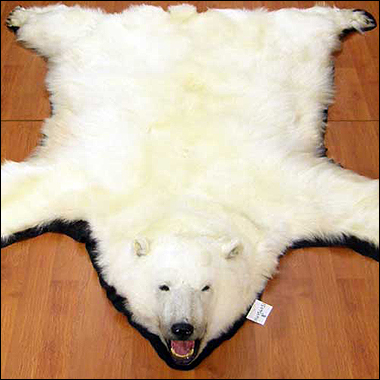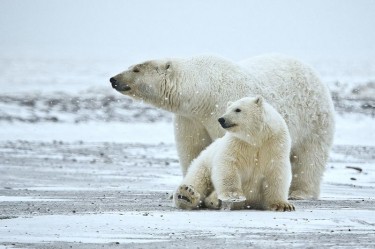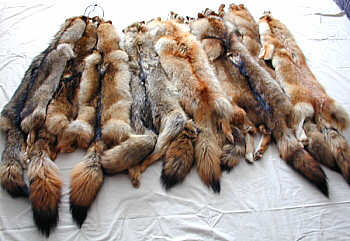Little did I know that Canada authorized the hunting, trapping and selling of polar bear hides. Yet, this should not have come as a surprise to me, but what may not be much of a surprise can genuinely be a concern with approximately 500 polar bear kills per year.
Before our emotions take over one must first try the grasp the scope of the industry, history and culture surrounding the market that is concerned with selling polar bear furs, skin and parts. We must regard conservation efforts and the traditional knowledge and understanding of the region through the lens of the First Nations people of North America, namely the Inuit in Canada.
Canada is home to 60% of the world’s polar bear population 15 000 of the 25 000 and unlike the giant panda bear which is the World WildLife Fund for Nature international symbol of conservation, the polar bear does not yet face such drastic threats, though this can be and is constantly refuted. In 2008 the US classified the polar bear as a threatened species, one bar away from endangered. However in Canada the species is listed under “special concern” which is two bars away from endangered. Of course this designation has political weight, under “special concern” the Canadian government can continue to implement conservation efforts which takes into account traditional and historical Aboriginal knowledge of polar bear populations that are said to be healthy, while continuing to facilitate an economic market.
Polar bear pelts can be sold from anywhere between $7,000 to $12,000 plus, double the price from two years ago. The reason for the increase frankly is that polar bear pelts may not be readily available in the future with the US government and environmental lobbyist placing pressure on the Canadian government to amend their status; a fight that the US lost last year and are likely to put even more resources to see their efforts bare fruit. This adds to the hike in prices as a last call for bear hides/pelts for buyers who can afford it before a band is placed on harvesting. (One must be careful not to always adopt US policies as the model for the entire world and other sovereign nations with considerations to their histories, cultures and government’s ability to conserve their natural and living resources.)
Aboriginal cultures were hunting, trapping and fur harvesting for their personal needs long before explorers made their way to Canada and the US. It was because of pelts that agreements and arrangements were made for the booming fur market in Europe as early as the late 1500?s. It was the Europeans dependence on this commodity that saw the shift in first nations coastal communities of hunters and fishers transform into trappers gaining in exchange metals, and change of diet that saw dry foods introduced. Also included in the furs that are distributed internationally and in Canada are, beavers, foxes, wolves, raccoons, bobcats, grizzly bears, black bears- coyote fur used in Canada Goose jackets and wolverine fur used in Northern Outfitters parkas.
Polar bear conservation efforts appear to be well managed however they are some zones that are not as well audited as others. Those zones also see an increase in trapping and killing for pelts with increasing demand. For instance Quebec is one province that does not enforce a quota or limit on kills for harvest. Their recent harvest numbers have scientist concerned about polar bear populations especially with climate changes affecting their habitat and ability to naturally sustain their numbers, comparing the cod phenomenon to what could possibly happen to the polar bears. (Cod conservation efforts were ignored until the cod in a particular region was completely depleted.)
Though polar bear furs are harvested in Canada, there is a standardized number per export for any given season. Where approximately 60 may be trapped and tanned for consumers, half that number will be authorized to be shipped outside of Canada. This process of regulating bear pelts on the international market tends to influence the hike in prices. Buyers from Russia, China, Japan and Europe, dominate the market, where traditional polar bear fur buyers mainly arrived from the United States, Greece, Italy and other nations in the past.
 All things considered, polar bear fur harvesting continually needs to be audited to maintain and retain a balance between nature and consumerism. Because polar bear trapping and other fur trappings are important to the livelihood of the aboriginal communities in the north, it is not as simple as suddenly outlawing/banning bear fur harvesting. However with a concerted effort between First Nations community leaders, scientist and governmental representation an agreement could be reached to more effectively conserve, and protect healthy polar bear populations while sustaining the economic livelihood of the people so dependant on this way of life.
All things considered, polar bear fur harvesting continually needs to be audited to maintain and retain a balance between nature and consumerism. Because polar bear trapping and other fur trappings are important to the livelihood of the aboriginal communities in the north, it is not as simple as suddenly outlawing/banning bear fur harvesting. However with a concerted effort between First Nations community leaders, scientist and governmental representation an agreement could be reached to more effectively conserve, and protect healthy polar bear populations while sustaining the economic livelihood of the people so dependant on this way of life.
About Author: Khamal Murray is a major in Bioethics & Heath Studies at the University of Toronto and a blogger/writer with http://thejuxtapositionape.blog.com and a special contributor with Alternavox Magazine
[wpsr_facebook][wpsr_retweet][wpsr_plusone]


